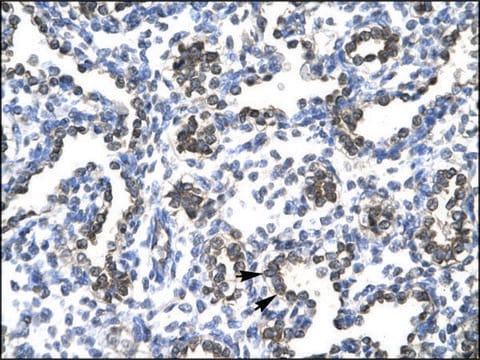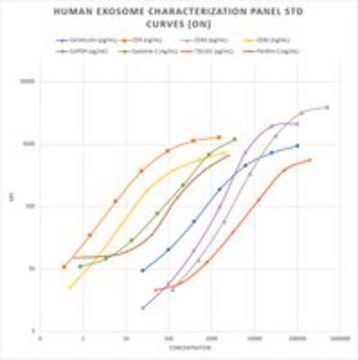General description
We are committed to bringing you greener alternative products, which adhere to one or more of The 12 Principles of Green Chemistry.This antibody is Preservative-free, produced without the harm or sacrifice of animals and exceptionally stable to allow for ambient shipping and storage if needed and thus aligns with "Waste Prevention", "Designing Safer Chemicals" and "Design for Energy Efficiency".
Click here for more information.
ZooMAb® antibodies represent an entirely new generation of recombinant monoclonal antibodies. Each ZooMAb® antibody is manufactured using our proprietary recombinant expression system, purified to homogeneity, and precisely dispensed to produce robust and highly reproducible lot-to-lot consistency. Only top-performing clones are released for use by researchers. Each antibody is validated for high specificity and affinity across multiple applications, including its most commonly used application. ZooMAb® antibodies are reliably available and ready to ship when you need them.
Specificity
Clone 3I8 is a ZooMAb® rabbit recombinant monoclonal antibody that specifically detects FosB protein. It targets an epitope within 20 amino acids from the C-terminal region.
Immunogen
KLH-conjugated linear peptide corresponding to 20 amino acids from the C-terminal region of human FosB.
Application
Quality Control Testing
Evaluated by Western Blotting in HL-60 cell lysate.
Western Blotting Analysis: A 1:1,000 dilution of this antibody detected FosB in HL-60 cell lysate.
Tested Applications
Immunohistochemistry (Paraffin) Analysis: A 1:100 dilution from a representative lot detected FosB in Human placenta tissue sections.
Immunocytochemistry Analysis: A 1:100 dilution from a representative lot detected FosB in HeLa cells.
Affinity Binding Assay: A representative lot of this antibody bound FosB peptide with a KD of 3.7 x 10-7 in an affinity binding assay.
Note: Actual optimal working dilutions must be determined by end user as specimens, and experimental conditions may vary with the end user.
Target description
Protein FosB (UniProt: P53539; also known as FosB proto-oncogene AP-1 transcription factor subunit, G0/G1 switch regulatory protein 3, Transcription factor AP-1 subunit FosB) is encoded by the FOSB (also known as G0S3) gene (Gene ID: 2354) in human. FosB is a member of the Fos family of transcription factors that is shown to accumulate in a subset of neurons of the nucleus accumbens and dorsal striatum following repeated administration of drugs of abuse. It persists in neurons for LONG® periods of time due to its high stability. The genic expression of FosB seems to be modified after LONG® time exposure to drugs of abuse and these changes may be involved in craving and addicted behavior. The FosB protein exhibits a truncated and stable splicing variant known as ΔFosB, whose accumulation is critical for the establishment of addictive behavior. FosB heterodimerizes with proteins of the Jun family to form an AP-1 transcription factor complex, thereby enhancing their DNA binding activity to gene promoters containing an AP-1 consensus sequence 5′-TGA[GC]TCA-3′. Together with Jun, it also plays a role in activation-induced cell death of T cells by binding to the AP-1 promoter site of Fas ligand (CD95L) and inducing its transcription in response to activation of the TCR/CD3 signaling pathway. Recurrent rearrangement of Fos and FosB are observed in the most common benign tumors of bone, osteoblastoma, and osteoid osteoma. This ZooMAb® recombinant monoclonal antibody, generated by our propriety technology, offers significantly enhanced specificity, Affinity™, reproducibility, and stability over conventional monoclonals. (Ref.: Anders, QS., et al. (2018). Front. Pharmacol. 9; 1205; Yin, Z., et al. (2017). Nucleic Acids Res. 45(19); 11425-11436; Baumann, S., et al. (2003). Oncogene. 22(9); 1333-1339; Nestler, EJ., et al. (2001). Proc. Natl. Acad. Sci. USA. 98(20); 11042-11046).
Physical form
Purified recombinant rabbit monoclonal antibody IgG, lyophilized in PBS, 5% Trehalose, normal appearance a coarse or translucent resin. The PBS/trehalose components in the ZooMAb formulation can have the appearance of a semi-solid (bead like gel) after lyophilization. This is a normal phenomenon. Please follow the recommended reconstitution procedure in the data sheet to dissolve the semi-solid, bead-like, gel-appearing material. The resulting antibody solution is completely stable and functional as proven by full functional testing. Contains no biocide or preservatives, such as azide, or any animal by-products. Larger pack sizes provided as multiples of 25 µL.
Reconstitution
300 µg/mL after reconstitution at 25 µL per vial. Please refer to guidance on suggested starting dilutions and/or titers per application and sample type.
Storage and Stability
Recommend storage of lyophilized product at 2-8°C; Before reconstitution, micro-centrifuge vials briefly to spin down material to bottom of the vial; Reconstitute each vial by adding 25 µL of filtered lab grade water or PBS; Reconstituted antibodies can be stored at 2-8°C, or -20°C for long term storage. Avoid repeated freeze-thaws.
Other Notes
Concentration: Please refer to the Certificate of Analysis for the lot-specific concentration.
Legal Information
Affinity is a trademark of Mine Safety Appliances Co.
LONG is a registered trademark of Repligen Sweden AB
ZooMAb is a registered trademark of Merck KGaA, Darmstadt, Germany
Disclaimer
Unless otherwise stated in our catalog or other company documentation accompanying the product(s), our products are intended for research use only and are not to be used for any other purpose, which includes but is not limited to, unauthorized commercial uses, in vitro diagnostic uses, ex vivo or in vivo therapeutic uses or any type of consumption or application to humans or animals.









